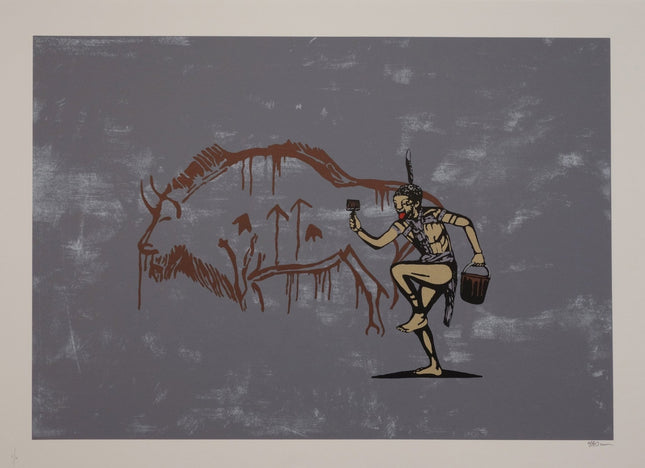
Tribal Druid & Native
-

Mad The Incredible Inka Silkscreen Print by Mad
The Incredible Inka 9-Color Hand-Pulled Limited Edition Silkscreen Print on 300gsm Fabriano Watercolour Paper by Mad Rare Street Art Famous Pop Artwork Artist. 2017 Signed & Numbered Limited Edition of 70 9 color Screen Print On Fabriano 300 gsm Paper of Native American Tribal Indian Graffiti Artist Cave Painting a Buffalo. The Incredible Inka by Mad The Incredible Inka is a stunning 9-color hand-pulled silkscreen print created by Mad, a prominent name in street pop art and graffiti artwork. Released in 2017 as a signed and numbered limited edition of 70, this piece masterfully combines themes of cultural heritage, artistic expression, and contemporary commentary. Printed on 300gsm Fabriano watercolor paper, the artwork captures the essence of tribal creativity through its depiction of a Native American figure creating cave art of a buffalo. The intricate layering of colors and textures adds depth to this evocative piece, making it a standout collectible. A Celebration of Tribal and Modern Art The Incredible Inka portrays a Native American tribal figure adorned in traditional attire, engaging in the act of creating cave art. The central imagery includes a bold depiction of a buffalo, rendered in earthy tones reminiscent of ancient rock paintings. This connection to heritage is contrasted with the tools and posture of the figure, which reflect a modern graffiti artist. The scene plays out on a gray, textured background that evokes the rough surfaces of cave walls, blending past and present seamlessly. The 9-color silkscreen process enhances the richness of the design, allowing each element to stand out while contributing to a cohesive composition. The Vision of Mad Mad, an influential artist in the realm of street pop art, is known for his ability to merge historical and cultural motifs with modern urban aesthetics. The Incredible Inka reflects his dedication to exploring themes of identity, legacy, and artistic evolution. By portraying a Native American tribal figure as a graffiti artist, Mad bridges the gap between ancient and contemporary forms of visual storytelling. His work often challenges viewers to reconsider their perceptions of art and its role in preserving and reinterpreting culture. A Rare and Collectible Artwork The Incredible Inka is part of a limited edition of 70 prints, each signed and numbered by Mad, ensuring its exclusivity and authenticity. The use of 300gsm Fabriano watercolor paper adds a tactile quality to the piece, complementing its visual impact. The 9-color silkscreen printing process showcases Mad’s commitment to precision and craftsmanship, resulting in a piece that is as durable as it is visually stunning. Its dimensions and rich design make it a statement piece for any collection of contemporary or street art. The Incredible Inka is more than an artwork; it is a dialogue between tradition and modernity. By blending tribal iconography with the rebellious spirit of graffiti artwork, Mad invites viewers to reflect on the continuity and evolution of artistic expression. This print stands as a testament to the enduring power of street pop art to connect diverse cultural narratives in a single, impactful piece.
$492.00


